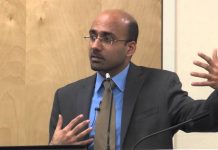
Economics has become a science of the loudmouth with numbers. Economists come on TV to show off that they have numbers and predictions. They will invent all kind of estimates and terms that no one has heard of to prove how erudite they are. But never will they submit themselves to peer review which is the international yardstick of quality work.
Whenever I hear them speak, I worry that this is not the economics I learnt — and I worked with about 10 Nobel laureates. These speakers and commentators always talk macro numbers — fiscal deficits and balance of payments, etc. — and always discuss simple accounting numbers with great aplomb. For example, “we must increase revenues because the government is losing money”? Never “why is government losing money like there is no tomorrow.” Then someone will yell “we have money to repay and import bills that must be met, so look for aid or borrowing.” Why did we borrow so much? Why are our import bills what they are? Why is the government borrowing at a faster rate than the economy is growing? These questions are never asked by our economists and therefore never debated.
Adam Smith, the father of economics authored the “Wealth of Nations” to initiate worldwide study of economics. Since then understanding the forces of growth, development and income distribution have been the most important areas of study in economics. Individual behavior — consumption, savings and investment decisions –are studied to understand how they can be tweaked for increased welfare. At the heart of economics is the quest for increasing human welfare through expanding opportunity for self-actualization through innovation, entrepreneurship and risk taking.
Is all government expenditure for public good?
Seldom will you hear our economists talk of the Smithian grand quest of growth, development and welfare. Led by international donors their quest is to malign Pakistan as a nation of tax cheats and a den of corruption. Revenues must be increased without telling us what, if anything, will the government do for us. They remain unaware that a large majority of Pakistanis are paying income tax on a withholding basis on many transactions. It is well known that this tax withheld is never returned.
The mantra is that the government needs the revenue and it must be increased. My fellow economists think that all revenues collected by government will be utilized productively for the welfare of the country. They never review the waste in the government: the numerous houses made for officials; the real estate developments made to provide plots to favorites; the wasteful and needless road widening for the cars of the rich; the expansion of sui gas pipelines even though we have run out of gas; whimsical projects that MNAs are allowed to direct for vanity reasons; wasteful expenditures on the PM or CM directives that are non-productive or too expensive; and ill thought out subsidies to the rich or political favorites.
The government is full of waste and no one wants to discuss this issue. Instead we are all ready to give it more money through a bad tax policy. The government has no money or time for clever research to promote economic transactions. The government has lost more than 3 trillion rupees in energy over the last 10 years. Unthinkingly this government is signing sovereign guarantees without thought or planning to build more and more energy. As a result, both the circular debt and energy cost are increasing to impose a huge cost on the economy. Yet, my fellow economists think that a wasteful inefficient and thoughtless government’s mistakes must be covered by more increased oppressive senseless taxation.
Where is growth and development?
Yet the biggest issue I take with my fellow economists is that they never focus on growth and productivity. At most there will be the usual plea for industrialization and export promotion, for both of which the only instrument seems to be more subsidy in one form or another. For over five decades, these economists have pushed the flawed strategy of promoting the government coddled industry and exports. Despite lackluster performance, considerable subsidies, many tax concessions, and much tariff protection, industry grows sporadically and exports as a percentage of GDP remain virtually static. Yet the mantra is maintained.
Economics in Pakistan has indeed become a set of mantras. They even go to the extent of saying, “we know what is to be done.” “We have all the solutions.” Basically, what they are saying is no new research is required. The old mantras of more taxation for more subsidy to industry and exports is enough. Mind you this has been firmly drilled into us through a series of large advocacy programs organized by very expensive donor funding. Why do donors fund advocacy? Why do we allow expensive propaganda against ourselves? I will never understand.
For the last 50 years or so, we have been running on these mantras with committees, task forces and many, many donor-funded consultants. Yet our long run growth seems to be declining as is our productivity. Few new industrial sectors have opened up while the old industry remains largely uncompetitive and cartelized if the Competition Commission is to be believed. The economy has grown thanks to the orphan sector that economists do not talk of — service or domestic commerce.
Einstein said that doing the same thing again and again and expect different results is insanity. Back then there was no donor funding! But now failed policies are repeated without much rethinking and it is not insanity. We merely call it “bad implementation.”
Our economists also have little to say about the mess that is the public sector. Another mantra prevails here: “just privatize.” No matter that our previous thoughtless privatizations were not as successful as we thought — badly priced, accusations of insider transactions, and some still not fully paid for. Is the purpose of privatization merely to rid the government of a bad asset? Why would someone buy a failing asset? Can even government monopolies be privatized? Is a private monopoly better than a public monopoly? Should privatization not improve the market and consumer welfare? Mantras don’t consider these possibilities.
Think city-markets-governance
How I would like economists to think differently? In my book, Looking Back: How Pakistan became and Asian Tiger in 2050, I have outlined a different approach. We must look at the economy as a complex system in which humans interact individually or in groups to learn, innovate and transact for their collective and individual welfare.
Spatially much of this interaction happens in cities where markets, institutions and the mass of people are located. Much of this activity is guided by laws and regulations that define markets both physical and virtual. Economic growth is driven by technology that people in cities strive to develop to increase the exchange of goods and services in the market place. Discovery through exchange lies at the heart of the human enterprise.
Conceptualizing the economy properly in this fashion immediately suggests that at the heart of the economy is the city and its markets and how they are governed. My fellow economists must ask themselves if we have this nexus of city-market-governance configured for the requirements of the 21st century?
The answer is immediately obvious. We do not.
The Pakistani state can probably best be described as an attempt at the preservation of the colonial structures for continued ‘control and extraction’ now for the brown elite instead of the empire. Much of the legal system, the judicial system and the executive and regulatory agencies continue to function as inherited. If any innovation was made in these, it was to introduce politicization and corruption. The shortfalls of this system are often measured in the Ease of Doing Business indicators of the World Bank. Sadly, these measures distract from the main point: the need to modernize the state — reform it into the 21st century.
How can you expect the city and the market that is organized by a state that is not only stuck in past practices but has also been distorted for personal gain to provide for the needs of progress and discovery? Our cities lack modernity and hotly contested spaces for various mafias, one of which is officialdom that enriches itself through controlling city land.
Similarly, the colonial state so used to ‘control and extraction’ gives huge advantages to vested interests such as large industry and large landlords. Antiquated laws and judicial systems make transactions and businesses extremely complicated to the cost of growth and welfare.
Is it possible to expect this state to deliver the kind of institutions, laws and governance system that the 21st century requires? If not, how do we expect good things like exports and taxes to increase?
The colonial state chokes investment
This state imposes a huge regulatory burden on the economy which does not seem to concern my friends. We estimated in the Framework for Economic Growth that I developed in the Planning Commission in 2011 that this regulatory burden may be as high as 70% of the size of the economy. It is clear that the economy is laboring under the yoke of obsolete, unreformed and distorted colonial governance structure. Yet this issue is not of central importance to the economist at large.
Frequently, commentator economists lament the lack of investment in the economy — the investment-GDP ratio remains at 15% of gross domestic product (GDP) whereas in India it is over 30% and in China it is 40%. Because these numbers are pronounced upon without understanding the structure of the economy, analysts seldom ask: “where is the room for investment?”
Dig deeper and you will find that the colonial enterprise is holding back investment in more ways than one.
As I state in Looking Back: How Pakistan became and Asian Tiger in 2050, the state controls over 70% of the market. With that big a footprint, market competition which is the premier driver of investment is crowded out by the state. In addition, crony capitalism which has captured the colonial state is able to erect barriers to entry in the form of SROs (statutory regulatory orders, bureaucratic code for selective tax exemptions), protective tariffs as well as exceptional access to inputs. In such an environment, investors correctly find limited opportunity.
As if this were not enough, the colonial state lacks specialized skills to manage the requirements of modern public good provision. Complex areas like energy and water management, city design and development and regulating markets are clearly of a lager era and far beyond the competence of the ‘control and extraction’ civil service.
The accumulated losses resulting from the poor management of the economy has led to repeated fiscal and balance of payments crises. IMF adjustment programs have frequently been requested but with little success in managing a policy coherence for sustainable growth. This policy uncertainty which once again arises from the lack of professional management of the economy, is a deterrent to investment.
Sprawls without commerce and investment space
Physically too space for investment has been severely restricted by the colonial hangover state. Modern city development was never a part of the colonial enterprise. They wanted people to continue living in old cities while the masters lived in airy suburbs. Natives had no need for serious enterprise. They would have small shops, limited schooling and limited space for modern activities. They needed to be controlled and the only enterprise necessary was to extract for the welfare of empire.
The bureaucracy and the army took over the role of the colonial state and immediately occupied the colonial habitations and proceeded to keep the colonial traditions alive. At first, they tried to keep everyone where they were to maintain the divide between the brown sahib and the natives. With the relentless population pressure, they had to reluctantly gave ground. They protected their colonial habitats which by then had become the center of city and were interfering with commercial development as well as with city mobility plans.
Tight controls on building were kept, preventing the development of organized density, commerce, leisure, and even education. For decades, city demand for space for commerce, storage and warehousing, offices, education, leisure, mobility and many other functions increased. All these developments were forced into the informal sector through encroachments or violations of poorly conceptualized colonial zoning. Even today we are going through a cycle of litigation and demolishing encroachments which arose because of poor city zoning that sought to prevent the natural growth of cities.
The poor, commerce, and other constituencies counted for little in the colonial model. But the growing elite, of which the bureaucracy, the army, and the judiciary were now a part, had to be accommodated. Responding to this demand as well as the availability of the car, the colonial state allowed for suburban development beyond the areas they had inherited from colonialism. As a result, cities have expanded to giant unmanageable sprawls with the centers being occupied by elite mansions and clubs instead of mixed-use high-rise development as in other cities of the world.
Choked up engines of growth
Early development advice suited the colonial bureaucracies for it prioritized industrial growth which policymakers conveniently put outside the city in industrial estates. They also derived further power since the development policy advice of the time emphasized planning industrial development through licenses, subsidies, cheap credit, protection, etc. — all of which were dispensed by the colonial bureaucracy.
The country has remained beset with this early development model refusing to see fresh developments in economics. Our PhD economists remain rooted in the past of the planning models vacillating between prioritizing between agriculture and industry and looking for exports. Domestic commerce, services and construction were deliberately repressed in an effort to develop what were thought to be leading sectors — industry and agriculture.
In 1996, the Nobel prize was awarded to Robert Lucas and in 2018 to his student Paul Romer. Both of them pointed to the engine of growth being the city, a place where people converge to exchange and share ideas, goods, money, services, space and activities. Many thinkers have pointed to the importance of the city in history as a crucible of innovation, entrepreneurship, knowledge and creativity. It has also been shown empirically that cities are engines of growth are dense, walkable with mixed use, high rise city centers. Unfortunately, our cities are sprawls with estates for colonial officials and polo grounds in the middle. And sadly, this research has not reached our policy economists who sit on task forces.
Construction always leads development. Even today, markets are continuously watching leading indicators many of which are based on construction activity. Go to any city in the world you will see tower cranes everywhere, many of them. A rapidly growing economy like China has sites that look like forests of tower cranes. Yet most Pakistani cities have hardly seen a tower crane. Look around you and you will see no tower cranes.
As analyzed above, in Pakistan, the continuation of the colonial enterprise has preserved colonial estates in the center of the city while also maintaining the colonial bias against enterprise in the middle of the city. To preserve this model, the colonial bureaucracy which controls the city has archaic zoning and building laws that are biased against density, walkability, mixed-use and high-rise. Is it any wonder that the construction industry is not a growth industry in this environment? Can we expect to accelerate our growth without a strong growth of construction based on real city development and not this colonial sprawl development?
Unlocking Dead Capital
There is an opportunity for real and sustained growth acceleration and for huge improvements in welfare if Prime Minister Imran Khan takes up the challenge of changing the city paradigm. He must uproot the colonial centers that are located in busy downtowns and allow high-rise mixed-use construction.
In most cities, city center land for urban regeneration is hard to get. The colonial enterprise has kept this precious capital inert for their private use and held back city development as well as employment and growth possibilities. It is time maker this dead capital work for us.
There is tremendous opportunity that is possible. The key challenge is going to be how to do it right for maximum public benefit. As an example, consider Lahore has more than 10,000 acres of prime commercial land held by the public sector in various areas. We must use this land for maximum value creation and employment gains. My tentative calculations show for only the five GORs (Government Officers Residences) which represent about 4,000 acres the following possibilities.
- We can make about 35 buildings of high-rise mixed-use buildings like Centaurus in Islamabad leaving more than half empty for greenery. Each costs, say, about $500 million, bringing the total investment required to $17.5 billion.
- Employment in construction is estimated at about 5,000 people per building directly employed, and a similar number indirectly employed, bringing the total amount of employment created during the construction phase to about 350,000–500,000 people.
- Each building will employ similar amounts or more when completed.
- At an average height of 35 floors, this will be 225 million square feet of construction for all uses.
It should not be made a speculative play for trading. It should not be hijacked by qabza mafias. This land represents a huge part of city wealth.
My suggestion would be for all cities to create City Wealth Funds which should own this land and have these funds professionally managed. Professional managers can develop projects and sell these as public private partnerships on a “build, operate, and transfer” basis. This could be a way for city to earn maximum revenue over a longer period of time. The time-bound nature of these contracts would force quick construction and returns.
Sadly, the Framework of Economic Growth (FEG) of the Planning Commission did present this approach to developing growth acceleration to the cabinet and parliament in 2011 and 2012. Though the FEG was approved, it was never implemented due to the opposition of the colonial bureaucracy to preserve its estates. It will require a strong government to do this and good process to make this happen professionally, protected from politics.
If we want to progress, we must truly end vestiges of colonialism and move into the 21st century.



















An interesting account of dead capital in Pakistan, a well explained notion coined by De Soto Peruvian economist in late 80’s. The author has unnecessarily blamed colonial forces for all ills in current Pakistan. Ultimately they developed the current infrastructure upon which we have based our civic and economic foundation for instance roads, bridges, cantonments, schools, colleges, and universities. The problem is with the local who failed to adjust with the new socio economic demands.
Yes our colonial laws are the real problem!
Great write up. It wont make any difference though. Best.
Kudos for Nadeemul Haque, for objective evaluation of ground realities and identifying the actual causes of current abysmal condition of our economy being the outdated system of government by the left our stooges of colonial masters. It was unfortunate that the founder the current died so early and spurious coins in his pocket as expressed by himself, three conspirators, two ICS ( Sikander Mirza and Ghulam Muhammad) and one politician, feudal lord Mushtaq Ghourmani took over the control to run it as pet colonial act of 1935 as described by Mian Allah Nawaz ex Chief Justice LHC in his book,”How can we Survive.” All the constitutions of 1956, 1962 and 1973 were built on the same act except some change of terms for cosmetic touch The so called consensus constitution of 1973 was mutilated within twenty hours to suit the whims of the creator to strengthen his suppressive control . It was further mutilated by successors including last two political dynasties to destroy by 175A act by inducting their stooges in higher Judiciary to save their skins when required as detailed in referred Mian Allah Nawaz’s book. So we are still stuck with colonial system though India did away with feudalism just after partition
Thus the pivotal institution of Judiciary has been destroyed by the agents of the vested interests to keep their oppressive and suppressive control on teeming hapless millions and ensuring continuity of statusquo
Those elite who can afford to live in suburbs are enjoying living in heart of cities while the less affluent ones are forced to move to suburbs ala Bahria Town. The Naya Pakistan Housing Program should be built on estates viz. the GORs.
Great analysis. One thing to emphasize. All great nations produce stuff, which either gets consumed domestically or exported. This has been the case since the beginning of time. Trade and commerce was the engine that created great empires like the China, Persia, India and in modern times Japan, Russia, US, China, Europe. They produced things that the world lined up to buy from them. When a nation produces things that are attractive to others, investment will come one way or the other.
Spot on. The analysis is correct. The solutions viable. What we need now is for the government somehow to understand this and implement. Is there a way?
The ideas are not feasible in accordance of govt budget. There is no policy to improve economic conditions.
Comments are closed.